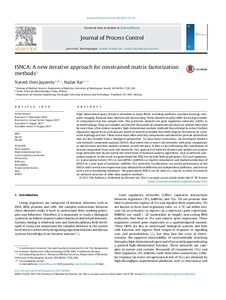ISNCA: A new iterative approach for constrained matrix factorization methods
Naresh Doni Jayavelu; Nadav Bar
ISNCA: A new iterative approach for constrained matrix factorization methods
Naresh Doni Jayavelu
Nadav Bar
ELSEVIER SCI LTD
Julkaisun pysyvä osoite on:
https://urn.fi/URN:NBN:fi-fe2021042718703
https://urn.fi/URN:NBN:fi-fe2021042718703
Tiivistelmä
High-dimensional, space of data is abundant in many fields, including medicine, machine learning, computer imaging, financial data, internet and data mining. These datasets usually suffer from large number of components but low sample sizes. One particular datasets are gene regulatory networks (GRNs) in systems biology. They are complex and involve thousands of components but they are seldom measured by more than a few dozens samples. High-dimensional analysis methods that attempt to extract hidden regulatory signals from such data are based on statistical models that often impose restrictions on a network topology and size. These restrictions often omit key components and therefore provide predictions that are less feasible from a biological perspective. To relax these restrictions, we developed iterative sub-network component analysis (ISNCA) that solves two or more sub-networks with joint components at one iteration and then updates solution at next iteration. It does so by subtracting the contribution of shared components from each sub-networks. Our approach of network division and update can analyze large networks that do not satisfy the restrictions of standard analysis algorithms, such as network component analysis. In this work, we generalized the ISNCA to include both target genes (TGs) and regulators, i.e. transcription factors (TFs) or microRNAs (miRNAs) as shared components and studied predictions of ISNCA to a new type of networks, miRNAs-TGs networks. Furthermore, we tested performance of the ISNCA with several new expression data obtained from different and independent platforms, and several new a priori knowledge databases. The generalized ISNCA can be used as a chassis to relax restrictions on network structure of other data analysis methods. (c) 2017 The Author(s). Published by Elsevier Ltd.
Kokoelmat
- Rinnakkaistallenteet [19207]
